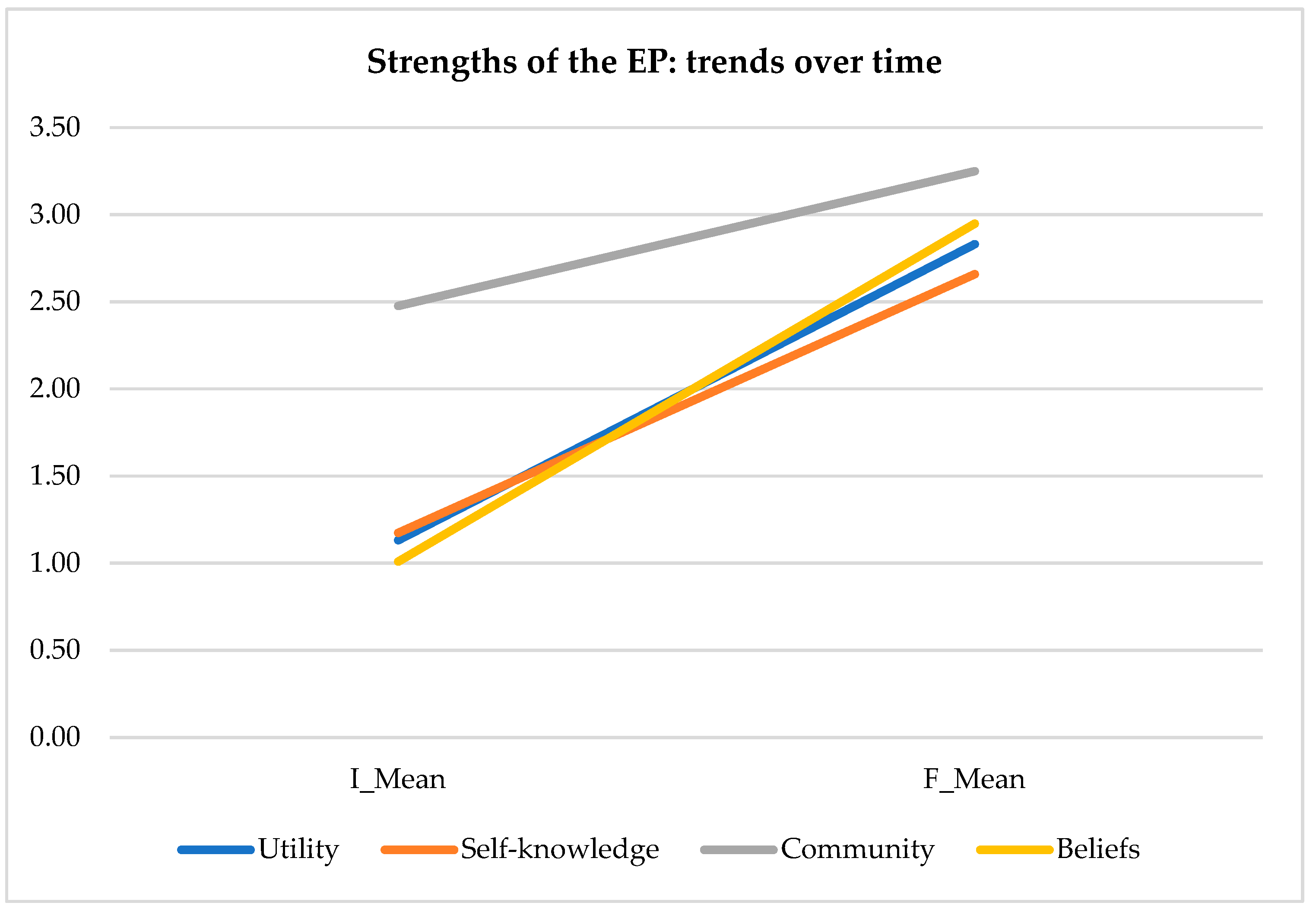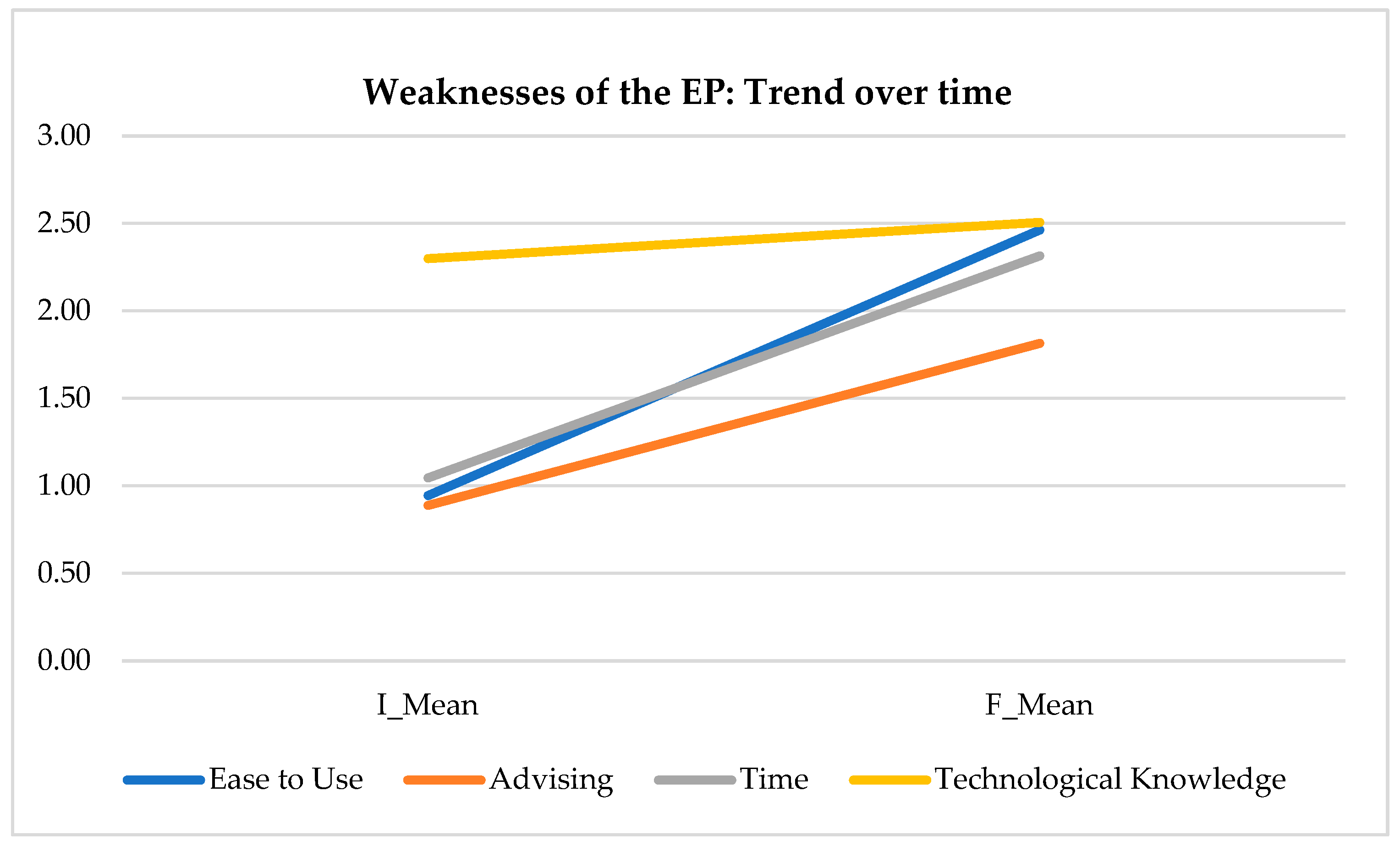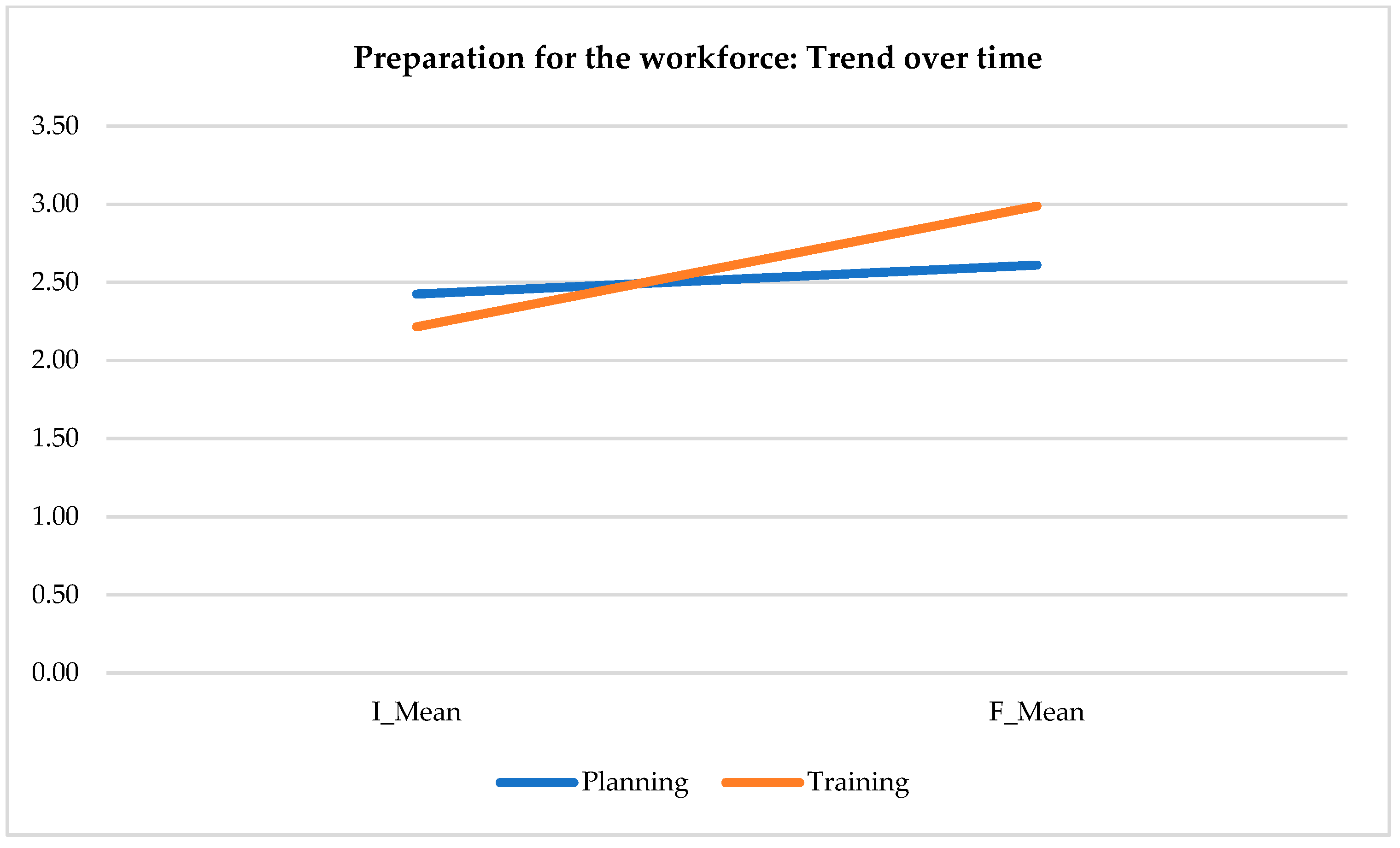Higher Education Students’ Perception of the E-Portfolio as a Tool for Improving Their Employability: Weaknesses and Strengths
Abstract
1. Introduction
1.1. The Role of EP in Preparing for Professional Practice
- Work experience/placements/internships;
- Professional advising and development of job skills;
- Participation in extracurricular activities;
- Attendance at networking or informational events in the industry;
- Part-time work;
- Volunteering/commitment to the community;
- Memberships/participation in professional associations.
1.2. The EP for Professional Improvement
- What is the perception of students on the EP’s strengths?;
- What is the perception of students on the EP’s weaknesses?;
- What is the perception of students on their training in Higher Education?
2. Materials and Methods
2.1. Instructional Design
2.2. Sample
2.3. Research Methodology
- -
- Utility (a useful tool for the job search, enables the network to expand, development of the professional competencies, greater visibility on the job market, help to contact employers, opens new professional horizons, a tool for permanent professional training);
- -
- Self-knowledge (development of critical thinking, help with self-reflection, self-evaluation, self-directed learning, self-efficacy);
- -
- Community (satisfaction when sharing and collaborating with classmates);
- -
- Beliefs (compatible use with the studies, positive attitude positive toward the use, EP is a creative and innovative tool, EP suits professional development needs).
- -
- Ease of use;
- -
- Technical advising to prepare an EP;
- -
- Time (benefits obtained with the EP compensate for the time invested in the preparation and updating);
- -
- Technological knowledge (video editing, podcast, photos and images, graphic design, webpage editing, social networks).
- -
- Planning (reflection and planning about professional future);
- -
- Training (university can help to find work, training for employability).
3. Results
3.1. Strengths of the EP
Correlations among the Elements in the Category Strengths
3.2. Weaknesses of the EP
Correlations among the Elements in the Category Weaknesses
3.3. Preparation for the Workforce
Correlations among Elements in the Category Preparation for the Workforce
3.4. Intercategory Correlations
4. Discussion and Conclusions
Author Contributions
Funding
Institutional Review Board Statement
Informed Consent Statement
Data Availability Statement
Conflicts of Interest
References
- Chang, K. EPortfolio for Skilled Immigrants and Employers: LIfIA Project. Phase One Final Report. 2006. Available online: http://www.futured.com/documents/Report-ePforSkilledImmigrants-LIfIA.pdf (accessed on 20 December 2021).
- Ahmed, E.; Ward, R. Analysis of factors influencing acceptance of personal, academic and professional development e-portfolios. Comput. Hum. Behav. 2016, 63, 152–161. [Google Scholar] [CrossRef]
- Carl, A.; Strydom, S. e-Portfolio as reflection tool during teaching practice: The interplay between contextual and dispositional variables. S. Afr. J. Educ. 2017, 37, 1250. [Google Scholar] [CrossRef]
- Faulkner, M.; Aziz, S.M.; Waye, V.; Smith, E. Exploring ways that ePortfolios can support the progressive development of graduate qualities and professional competencies. High. Educ. Res. Dev. 2013, 32, 871–887. [Google Scholar] [CrossRef]
- Kabilan, M.K. Using Facebook as an e-portfolio in enhancing pre-service teachers’ professional development. Australas. J. Educ. Technol. 2016, 32, 19–31. [Google Scholar] [CrossRef]
- Kinash, S.; Crane, L.; Judd, M.-M.; Knight, C. Discrepant stakeholder perspectives on graduate employability strategies. High. Educ. Res. Dev. 2016, 35, 951–967. [Google Scholar] [CrossRef]
- Slepcevic-Zach, P.; Stock, M. ePortfolio as a tool for reflection and self-reflection. Reflective Pract. 2018, 19, 291–307. [Google Scholar] [CrossRef]
- Hampe, N.; Lewis, S. E-portfolios support continuing professional development for librarians. Aust. Libr. J. 2013, 62, 3–14. [Google Scholar] [CrossRef]
- Lai, M.; Lim, C.P.; Wang, L. Potential of digital teaching portfolios for establishing a professional learning community in higher education. Australas. J. Educ. Technol. 2016, 32, 1–14. [Google Scholar] [CrossRef]
- Chang, C.-P.; Lee, T.-T.; Mills, M.E.; Hsieh, Y.-P. E-portfolio functional requirements for the final semester baccalaureate practicum course: A qualitative research study. J. Prof. Nurs. 2019, 35, 405–411. [Google Scholar] [CrossRef]
- Ciesielkiewicz, M. El porfolio electrónico como recurso educativo y su impacto en la búsqueda de trabajo. Rev. Tecnol. Cienc. Y Educ. 2015, 2, 83–99. [Google Scholar] [CrossRef]
- Alam, F.; Chowdhury, H.; Kootsookos, A.; Hadgraft, R. Scoping e-portfolios to engineering and ICT educa-tion. 6th International Conference on Thermal Engineering, ICTE. Procedia Eng. 2015, 105, 852–857. [Google Scholar] [CrossRef][Green Version]
- Ciesielkiewicz, M. The use of e-portfolios in higher education: From the students’ perspective. Issues Educ.-Al Res. 2019, 29, 649–667. [Google Scholar]
- Clarke, M. Rethinking graduate employability: The role of capital, individual attributes and context. Stud. High. Educ. 2017, 43, 1923–1937. [Google Scholar] [CrossRef]
- Fowlie, J.; Forder, C. Can students be ‘nudged’ to develop their employability? Using behavioural change methods to encourage uptake of industrial placements. J. Educ. Work 2020, 33, 154–168. [Google Scholar] [CrossRef]
- Munday, J.; Rowley, J. Showing a human and professional face to the world: An ePortfolio design strategy for a sense of self. In Handbook of Research on Humanizing the Distance Learning Experience; Northcote, M., Gosselin, Y.K.P., Eds.; IGI Global: Hershey, PA, USA, 2017; pp. 94–110. [Google Scholar]
- Bennett, D. Graduate employability and higher education: Past, present, and future. HERDSA Rev. High. Educ. 2018, 5, 32–61. [Google Scholar]
- Clarke, J.L.; Boud, D. Refocusing portfolio assessment: Curating for feedback and portrayal. Innov. Educ. Teach. Int. 2016, 55, 479–486. [Google Scholar] [CrossRef]
- Jorre, T.J.D.S.; Oliver, B. Want students to engage? Contextualise graduate learning outcomes and assess for employability. High. Educ. Res. Dev. 2018, 37, 44–57. [Google Scholar] [CrossRef]
- Beckers, J.; Dolmans, D.; Van Merriënboer, J. E-Portfolios enhancing students’ self-directed learning: A system-atic review of influencing factors. Australas. J. Educ. Technol. 2016, 32, 32–46. [Google Scholar] [CrossRef]
- Pool, A.O.; Govaerts, M.J.B.; Jaarsma, D.A.D.C.; Driessen, E.W. From aggregation to interpretation: How assessors judge complex data in a competency-based portfolio. Adv. Health Sci. Educ. 2018, 23, 275–287. [Google Scholar] [CrossRef]
- Hallam, G.; Creagh, T. ePortfolio use by university students in Australia: A review of the Australian ePortfolio Project. High. Educ. Res. Dev. 2010, 29, 179–193. [Google Scholar] [CrossRef][Green Version]
- Okolie, U.C.; Igwe, P.A.; Nwosu, H.E.; Eneje, B.C.; Mlanga, S. Enhancing graduate employability: Why do higher education institutions have problems with teaching generic skills? Policy Futur. Educ. 2020, 18, 294–313. [Google Scholar] [CrossRef]
- Olivares-García, M.A.; García-Segura, S.; Gutiérrez-Santiuste, E.; Mérida-Serrano, R. El e-portafolio profesional: Una herramienta facilitadora en la transición al empleo de estudiantes de Grado en Educación Social en la Universidad de Córdoba. REOP—Revista Española de Orientación y Psicopedagogía 2020, 31, 129–148. [Google Scholar]
- Reddy, M.C.R. Employability in Higher Education: Problems and Prospectives. South Asian Res. J. Bus. Manag. 2019, 1, 112–117. [Google Scholar] [CrossRef]
- Krouwel, S.J.C.; Van Luijn, A.; Zweekhorst, M.B. Developing a processual employability model to provide education for career self-management. Educ. Train. 2019, 62, 116–128. [Google Scholar] [CrossRef]
- Osmani, M.; Weerakkody, V.; Hindi, N.; Eldabi, T. Graduates employability skills: A review of literature against market demand. J. Educ. Bus. 2019, 94, 423–432. [Google Scholar] [CrossRef]
- Mapundu, M.; Musara, M. E-Portfolios as a tool to enhance student learning experience and entrepreneurial skills. S. Afr. J. High. Educ. 2019, 33, 191–214. [Google Scholar] [CrossRef]
- Yang, M.; Tai, M.; Lim, C.P. The role of e-portfolios in supporting productive learning. Br. J. Educ. Technol. 2016, 47, 1276–1286. [Google Scholar] [CrossRef]
- Ritzhaupt, A.D.; Singh, O.; Seyferth, T.; Dedrick, R.F. Development of the Electronic Portfolio Student Perspective Instrument: An ePortfolio integration initiative. J. Comput. High. Educ. 2008, 19, 47–71. [Google Scholar] [CrossRef]
- Haffling, A.-C.; Beckman, A.; Pahlmblad, A.; Edgren, G. Students’ reflections in a portfolio pilot: Highlighting professional issues. Med. Teach. 2010, 32, e532–e540. [Google Scholar] [CrossRef][Green Version]
- Schneider, J.; O’Hara, K.; Munro, I. Using Continuing Professional Development with Portfolio in a Pharmaceutics Course. Pharmacy 2016, 4, 36. [Google Scholar] [CrossRef]
- Machado, M.F.; Urbanetz, S. Contributions of the digital portfolio for the evaluative praxis in higher educa-tion. Rev. Complut. Educ. 2020, 31, 285–293. [Google Scholar] [CrossRef]
- Ross, S.; MacLachlan, A.; Cleland, J. Students’ attitudes towards the introduction of a Personal and Professional Development portfolio: Potential barriers and facilitators. BMC Med. Educ. 2009, 9, 69. [Google Scholar] [CrossRef] [PubMed]
- Andre, K. E-Portfolios for the aspiring professional. Collegian 2010, 17, 119–124. [Google Scholar] [CrossRef] [PubMed]
- Abuzaid, M.M.; Elshami, W.; David, L.; Stevens, B. Perceptions of e-portfolio use in lifelong learning and pro-fessional development among radiology professionals. Curr. Med. Imaging Rev. 2007, 13, 495–501. [Google Scholar]
- Miller, P.A.; Tuekam, R. The Feasibility and Acceptability of Using a Portfolio to Assess Professional Competence. Physiother. Can. 2011, 63, 78–85. [Google Scholar] [CrossRef]
- Flick, U. An Introduction to Qualitative Research, 5th ed.; Sage: London, UK, 2014. [Google Scholar]
- Gerring, J. Case Study Research: Principles and Practices; Cambridge University Press: Cambridge, UK, 2006. [Google Scholar]
- Faculty of Education. Social Education (n.d.). Justificación. Available online: http://www.uco.es/educacion/es/grado-en-educacion-social#justificacion (accessed on 20 December 2021).
- DeVellis, R.F. Scale Development: Theory and Applications; SAGE Publications: Los Angeles, CA, USA, 2017; pp. 50–100. [Google Scholar]
- Cohen, J.W. Statistical Power Analysis for the Behavioral Sciences, 2nd ed.; Lawrence Erlbaum Associates: Hillsdale, NJ, USA, 1988. [Google Scholar]
- Pallant, J. SPSS. Survival Manual; McGraw-Hill: New York, NY, USA, 2017. [Google Scholar]
- Marinho, P.; Fernandes, P.; Pimentel, F. The digital portfolio as an assessment strategy for learning in higher education. Distance Educ. 2021, 42, 253–267. [Google Scholar] [CrossRef]



| Initial | Final Questionnaire | Difference Initial–Final | |
|---|---|---|---|
| Strengths | |||
| Utility | 1.13 | 2.83 | 1.70 |
| Self-knowledge | 1.17 | 2.66 | 1.49 |
| Community | 2.48 | 3.25 | 0.77 |
| Beliefs | 1.01 | 2.95 | 1.94 |
| Weaknesses | |||
| Ease to Use | 0.94 | 2.46 | 1.52 |
| Advising | 0.89 | 1.81 | 0.93 |
| Time | 1.05 | 2.31 | 1.27 |
| Technological Knowledge | 2.30 | 2.51 | 0.21 |
| Preparation for the workforce | |||
| Planning | 2.43 | 2.61 | 0.19 |
| Training | 2.22 | 2.99 | 0.77 |
| Subcategory | t (Student) | Pre-Test | Post-Test | Mean Difference | SE | df | p | r * | Cohen’s d * | ||
|---|---|---|---|---|---|---|---|---|---|---|---|
| SD | SD | ||||||||||
| Utility | 8.97 | 1.13 | 1.42 | 2.83 | 0.65 | 1.69 | 1.89 | 53 | 0.00 | 0.36 | 0.78 |
| Self-knowledge | 6.62 | 1.17 | 1.55 | 2.66 | 0.83 | 1.48 | 0.22 | 53 | 0.00 | 0.49 | 1.13 |
| Community | 5.49 | 2.47 | 0.83 | 3.25 | 0.66 | 0.77 | 0.14 | 53 | 0.00 | 0.46 | 1.03 |
| Beliefs | 9.42 | 1 | 1.35 | 2.95 | 0.70 | 1.93 | 0.20 | 53 | 0.00 | 0.67 | 1.81 |
| Subcategory | t (Student) | Pre-Test | Post-Test | Mean Difference | SE | df | p | r * | Cohen’s d * | ||
|---|---|---|---|---|---|---|---|---|---|---|---|
| SD | SD | ||||||||||
| Ease of Use | 8.06 | 0.94 | 1.29 | 2.46 | 0.77 | 1.51 | 1.38 | 53 | 0.00 | 0.58 | 1.43 |
| Advising | 4.91 | 0.89 | 1.24 | 1.81 | 0.95 | 0.92 | 1.38 | 53 | 0.00 | 0.38 | 0.83 |
| Time | 6.18 | 1.04 | 1.45 | 2.31 | 0.94 | 1.29 | 1.50 | 53 | 0.00 | 0.46 | 1.04 |
| Technological Knowledge | 4.06 | 2.30 | 0.43 | 2.50 | 0.43 | 0.20 | 0.37 | 53 | 0.00 | 0.24 | 0.51 |
| Utility | Self-Knowledge | Community | |
|---|---|---|---|
| Self-knowledge | 0.503 * | ||
| Community | 0.430 * | 0.414 * | |
| Beliefs | 0.752 * | 0.615 * | 0.666 * |
| Sub- Category | t (Student) | Pre-Test | Post-Test | Mean Difference | SE | df | p | r * | Cohen’s d * | ||
|---|---|---|---|---|---|---|---|---|---|---|---|
| SD | SD | ||||||||||
| Planning | 1.52 | 2.42 | 0.90 | 2.61 | 0.69 | 0.18 | 0.89 | 53 | 0.133 | 0.11 | 0.22 |
| Training | 5.43 | 2.21 | 1.09 | 2.98 | 0.62 | 0.77 | 1.03 | 53 | 0.000 | 0.40 | 0.87 |
| Ease of Use | Advising | Time | |
|---|---|---|---|
| Advising | 0.016 | ||
| Time | 0.186 | −0.134 | |
| Technological Knowledge | 0.133 | −0.135 | −0.163 |
Publisher’s Note: MDPI stays neutral with regard to jurisdictional claims in published maps and institutional affiliations. |
© 2022 by the authors. Licensee MDPI, Basel, Switzerland. This article is an open access article distributed under the terms and conditions of the Creative Commons Attribution (CC BY) license (https://creativecommons.org/licenses/by/4.0/).
Share and Cite
Gutiérrez-Santiuste, E.; García-Segura, S.; Olivares-García, M.Á.; González-Alfaya, E. Higher Education Students’ Perception of the E-Portfolio as a Tool for Improving Their Employability: Weaknesses and Strengths. Educ. Sci. 2022, 12, 321. https://doi.org/10.3390/educsci12050321
Gutiérrez-Santiuste E, García-Segura S, Olivares-García MÁ, González-Alfaya E. Higher Education Students’ Perception of the E-Portfolio as a Tool for Improving Their Employability: Weaknesses and Strengths. Education Sciences. 2022; 12(5):321. https://doi.org/10.3390/educsci12050321
Chicago/Turabian StyleGutiérrez-Santiuste, Elba, Sonia García-Segura, María Ángeles Olivares-García, and Elena González-Alfaya. 2022. "Higher Education Students’ Perception of the E-Portfolio as a Tool for Improving Their Employability: Weaknesses and Strengths" Education Sciences 12, no. 5: 321. https://doi.org/10.3390/educsci12050321
APA StyleGutiérrez-Santiuste, E., García-Segura, S., Olivares-García, M. Á., & González-Alfaya, E. (2022). Higher Education Students’ Perception of the E-Portfolio as a Tool for Improving Their Employability: Weaknesses and Strengths. Education Sciences, 12(5), 321. https://doi.org/10.3390/educsci12050321








